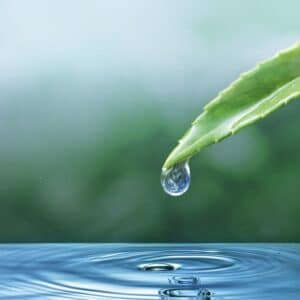Making cosmetics is all about control and repeatability. Each ingredient must react predictably, remain stable and provide the desired effect, and surprisingly, that often starts with the simplest ingredient: water. Distilled water is not just a base. It is a conscious choice for those who want to develop reliable, skin-friendly and stable formulas. Whether you’re creating a hydrating toner, a light gel serum or an artisanal soap, distilled water for skincare and distilled water for cosmetics offers you the purity and consistency that ordinary tap water cannot guarantee.
What is distilled water?
Distilled water is created by heating water to steam, and then condensing that steam into liquid. During this process, minerals, heavy metals and other impurities are removed. The result is a clean, neutral base that will not affect the color, smell or texture of your finished product. Whereas tap water can vary depending on the region or season, distilled water offers consistent quality. That makes it ideal for recipes where even small variations can have a big effect, such as in serums, facial mists and leave-on products.
Why do makers choose distilled water?
With leave-on formulas, such as toners, lotions and essences, the product remains on the skin for hours. Any disruption, such as mineral residues or an unexpected pH change, can affect both efficacy and skin tolerance. Distilled water for skincare ensures that active ingredients such as niacinamide, panthenol or hyaluronic acid dissolve properly and retain their action. In rinse-off products such as cleansing gels or shampoos, distilled water also contributes to an even lather and clear texture. For example, you avoid a cloudy gel or a pH deviation that makes the formula unstable.
Distilled water in cosmetics: more than just face
The benefits of distilled water for cosmetics extend beyond skincare. Think of hairmists, aftershaves, eye makeup removers or body sprays. In all of these products, low mineral water helps keep fragrances stable, thickeners working properly and emulsions clear.
When you sell your products on a larger scale, distilled water ensures that each batch maintains the same quality. This not only makes production more reliable, but also helps with your PIF documentation and safety assessments.
And what about soap making?
In cold process soap, water plays a silent but crucial role. Lime and magnesium from tap water can react with lye and lead to discoloration or soaps that don’t cure properly. Distilled water for cosmetics prevents such reactions, giving you consistently beautiful, smooth soap blocks. Colors such as micas and clays stay brighter, and the gel phase proceeds more evenly.
For hobbyists, tap water may be sufficient for personal batches. But once you want sales or reproducible results, distilled water for skincare or soap is the logical step.
What is the difference between distilled and demineralized water?
Both types of water are highly purified, but through a different process. Distilled water is obtained via evaporation, while demineralized water uses ion exchange to remove dissolved salts. For most applications in DIY cosmetics, the results are similar. What really matters is purity AND how you handle it: work cleanly, process quickly and store properly.
At YouWish, we recommend distilled water for those who want reliable repeatability in sensitive products such as facial mists or soaps. Our distilled water for cosmetics is cosmetic grade, suitable for a variety of applications, and easy to combine with other ingredients in our range.
Making products with YouWish: ingredients, packaging and tools
YouWish provides the components that convert distilled water into finished products. For hydrating toners, you can use glycerin, hyaluronic acid, panthenol and niacinamide. For gel textures, choose a clear polymer base. For lotions, choose an emulsifier system that matches your oil phase. For fragrance, use cosmetic fragrances or essential oils in safe amounts. For preservation, you store a broad-spectrum blend that matches your pH. For quality control, add pH strips or a meter, mixing cups and spatulas. With these components, distilled water for skincare becomes a complete product line. With chelators, dyes and micas, distilled water for cosmetics fills the rest of your shelf. With safe equipment for handling lye, distilled water for soap making forms the basis for a reliable soap range.
Formulation Patterns that work
Hydrating toner (water thin, do not rinse off)
Don’t make the base too complicated. First, use distilled water. Add a small amount of hyaluronic acid, a soothing active ingredient, and a modest amount of glycerin. Adjust the pH for skin comfort. Store the bottle in an airtight atomizer. This sets the tone for your brand and is a classic use of distilled water for skincare.
Clear gel serum (soft, leave in)
Use distilled water, panthenol, niacinamide and a polymer gel. Check the clarity in cold and hot storage. The gel will remain clear on the shelf if the base is kept clean. This gives your customers a quick overview of the benefits of using distilled water for cosmetics.
Make-up remover in two stages (rinse off)
Combine distilled water, mild solvent and light oil phase. Shake before use. Even after shipping, clear water helps in the clean separation of the two phases.
Lye solution for cold-pressed soap
To make soap, measure out the distilled water and gradually add the lye. Mix this in a well-ventilated room. Record the temperature and note the time. When distilled water is used instead of tap water to make soap, many manufacturers see consistency results.
Frequently Asked Questions
V1. Is distilled water always needed for skin care?
Yes, for most products you leave on your skin. Using distilled water for skincare helps preserve ingredients and minimizes disruption. It also helps with rinsing and keeps the gel clear.
V2. Do distilled and deionized water have the same properties?
Both contain fewer minerals. For independent work, the results are similar in practice. Clean processing and a good preservative are more important than the discussion of distilled versus deionized water.
V3. Can I use a pitcher of purified water?
Check the procedure and TDS. It can work if the specifications are stable. Distilled water versus purified water often ends with “use distilled” for easy, repeatable runs because many brands still prefer distilled water for stability.
V4. What about aloe juice or hydrosols?
These increase variables while adding claims or fragrance. For cosmetics, start with distilled water and work from there. Add hydrosols after you have established pH and base.
V5. Is it possible to produce distilled water at home?
There are devices for home use, but they are difficult to control. Buy sealed bottles for sale. Fresh, sealed distilled water saves time, but small quantities for home use can be used for trials.
Conclusion
A stable base makes for stable products. Distilled water keeps the base clean and your process simple. If you want to make a toner, a gel serum, a makeup remover or a soap range, start with distilled water for skincare, distilled water for cosmetics and distilled water for soap making, where applicable. If you have to choose between distilled water and deionized water or distilled water and purified water, choose the option you can keep consistent and document well.
Discover YouWish for ingredients, packaging and tools that can turn a clean into a market-ready assortment. Put together one formula, then a set, then a full routine. Your products will be as clear as the water they contain.

